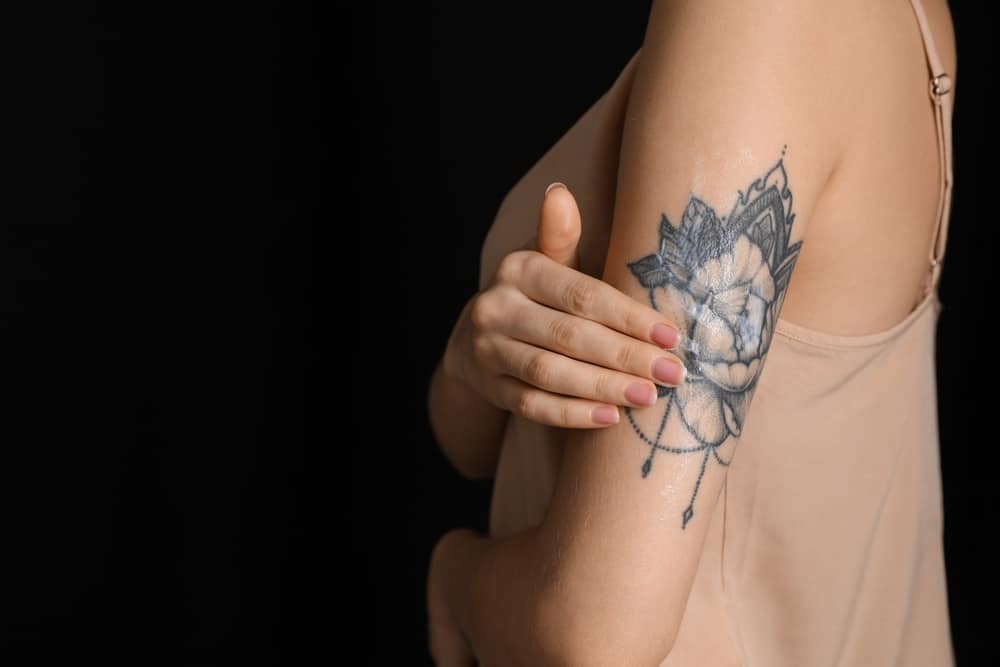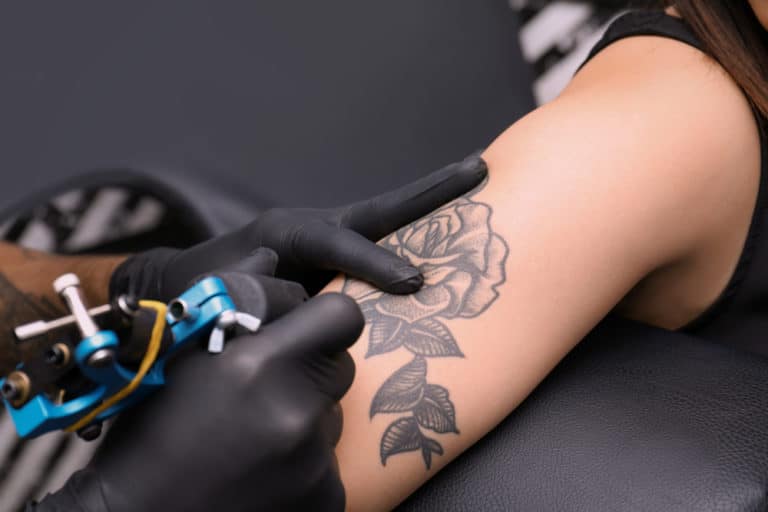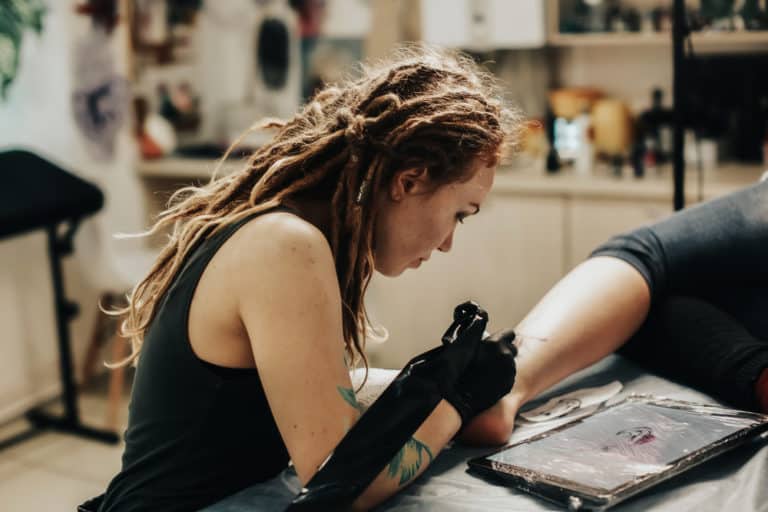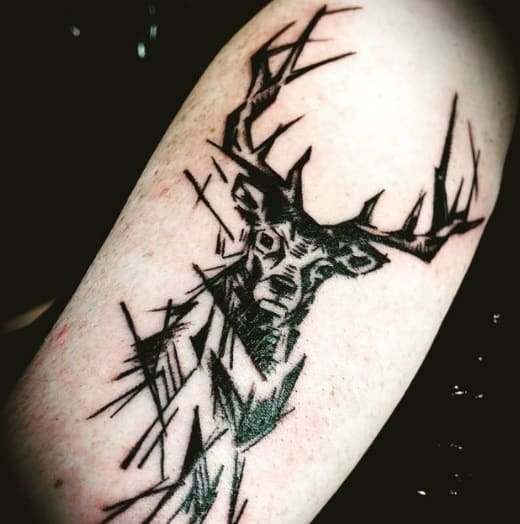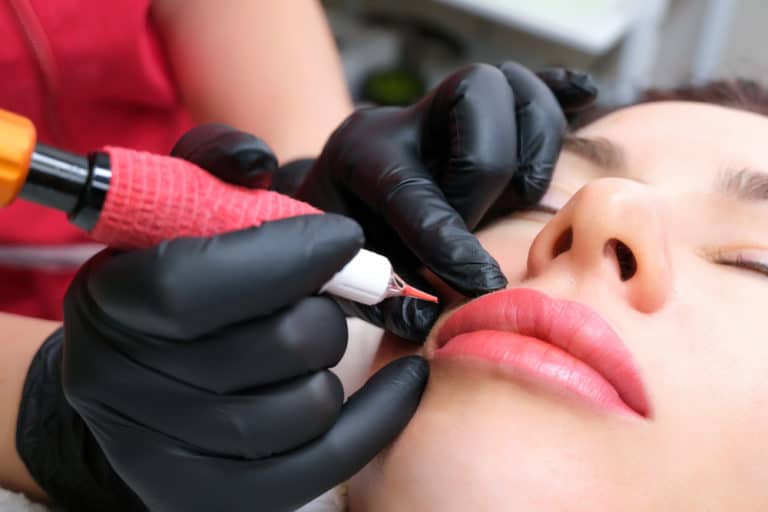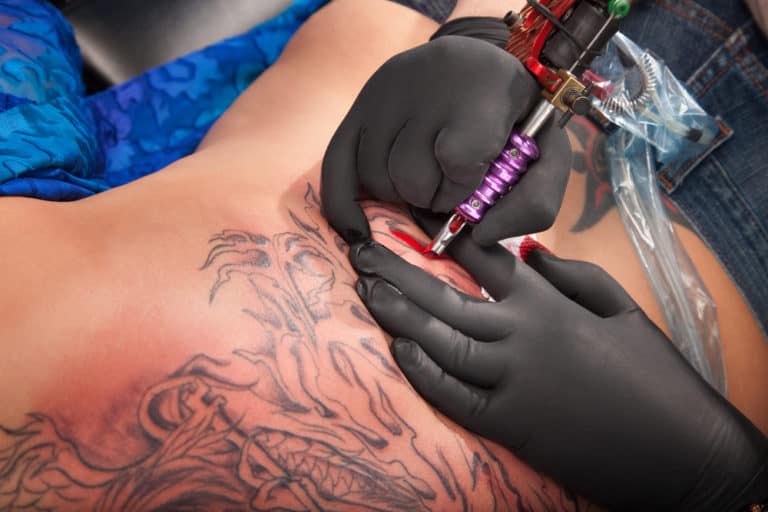New Tattoo Looks Faded And Milky
Getting new body art is exciting, so you can’t wait to show it off to everyone. In the studio, the tender new image looks fantastic on your skin. But a few days later, the vivid colors fade, and the tattoo has an unappealing milky sheen. What’s gone wrong? Why does a new tattoo look faded and milky?
A new tattoo can look faded and milky while healing as a temporary cloudy layer of skin develops. Follow recommended aftercare procedures: do not scratch the tattoo, keep it hydrated, avoid the sun, and stay out of water. A faded tattoo can also be caused by infection or an unskilled artist.
It can be quite a shock to notice that your fresh ink looks dull and cloudy, even when you’ve been following the tattoo artist’s advice. After a couple of weeks, the tattoo should return to its vibrant beauty once the healing process is completed.
Cause OF Faded Tattoo: A Sign of Healing
The usual reason a new tattoo looks faded and milky is that it is still healing. The healing process consists of three stages and may take between a week and a couple of months, depending on your new body art’s location and size and how you care for it.
Let’s look at how a tattoo heals to understand why a freshly inked tattoo can appear milky.
Tattoo Healing Stage 1: Inflammation (Days 1-3)
Your body doesn’t recognize a tattoo as a work of art. Instead, your body sees it as a wound and reacts by healing the epidermis that the needle has penetrated.
Before leaving the studio, your tattoo artist will have covered the stunning new body art with a medical-grade bandage or plastic film. You can remove the plastic after four hours, while a medical film can stay on the wound for two days.
As soon as the cover is off, wash the tattoo gently to remove any blood and fluid. Pat it dry and apply a meager layer of the lotion or ointment your artist recommends.
Your tattoo will be inflamed for the first three days (up to a week for large pieces). In other words, you will feel swelling, irritation, discomfort, and even pain.
It is usual for the wounded skin to ooze blood, ink, and a clear fluid called plasma. This seeping is part of the healing process and not a sign of infection. Wash the tattoo carefully twice daily with antibacterial soap, then pat dry and apply lotion.
By day three, you should feel better as the tattoo begins forming a scab.
Tattoo Healing Stage 2: Visible Recovery (Days 4-18)
Over the next two weeks, the skin forms a scab over the tattoo, as your body would with any scrape that’s healing. The skin on the tattoo may itch and flake off.
At this stage, is it essential that you follow your tattoo artist’s aftercare advice, which usually includes the following:
- Do not scratch the scab or pull off flaky skin, however much it itches. There may be bacteria under your nails that will infect the wound. Always remember to wash your hands before touching your tattoo.
- Keep the tattoo hydrated with the lotion your artist recommends. Most aftercare lotions also numb the itch and irritation.
- Avoid tight clothing that may rub or compress the tattoo. Do not cover the tattoo as the skin needs to breathe to heal.
- Keep the tattoo out of sunlight.
- Avoid swimming or bathing. Take a quick shower instead. If the tattoo does get wet, dry it by blotting it with a towel. Apply lotion immediately.
Tattoo Healing Stage 3: The Milky Stage (Days 18-30)
Fading and milkiness are such a common part of the healing process that the third stage (invisible recovery) is called the milky stage. This stage takes between two weeks and two months, so you need to be patient if you’ve had a big piece.
The milky stage can be alarming for those who’ve been inked for the first time. Even though the scabs have fallen off, the tattoo will still look dull and cloudy. Your skin may also feel tight. The discoloration and odd sensation are natural as your body is in the final throes of healing.
At this stage, your body is generating a new layer of skin to replace the top layer of skin damaged by your braving the needle. The tattoo itself remains on an inner layer of skin and gets covered by the epidermis, which doesn’t contain ink.
While the body heals, it uses the dry, damaged skin cells to form a translucent protective layer over the tattoo. This additional defense layer gives the tattoo a milky sheen. Once the new skin has grown, the outer layer will flake off.
For the most effective and quickest healing, continue to protect and nurture your skin:
- Keep your hands away from the tattoo. Do not try to rub, scratch, scrape or pick off the milky layer of skin. The tender skin underneath is still healing, and damaging it will extend the healing period. Fiddling with the tattoo can cause bleeding, scabbing, scarring, and even infection.
- Avoid clothing that rubs on the tattoo as the friction will delay healing.
- Continue to avoid sunlight on the tattoo. Try to keep the tattoo in the shade or wear protective clothing. If you must go in the sun, cover the tattoo with sunscreen.
- Hydration is vital to keep the growing skin healthy. Keep applying tattoo lotion and butter regularly. The tattoo must remain moist but not wet, with a layer of ointment preventing it from breathing.
- Continue to stick to showers and not bath or swim while the milky layer heals. Use a specialized tattoo foam soap.
Don’t worry – the cloudy surface skin will peel away naturally as it does after a sunburn. Your gorgeous body art will be revealed with a fresh layer of skin in all its colorful glory.
Cause of Faded Tattoo: Dry Skin
A second reason for your tattoo being faded and milky is that your skin is too dry, leading to you rubbing and scratching it.
You’ll notice this problem if your tattoo brightens when you’ve moisturized but fades quickly. The chances are that you were diligent about applying lotion for the first weeks of healing, as recommended by the tattoo artist, but your aftercare regimen has slacked off.
During the healing process, your skin grows a layer of healthy skin to replace the damaged skin over the tattoo. If you don’t hydrate the skin adequately, the new skin will struggle to replace the damaged cells and will be uneven, rough, and dry.
Lingering dryness and peeling leeches pigment from the tattoo, making it faded and milky after healing.
The best remedy for dry skin and a milky tattoo is to slather on ointment regularly to replenish the missing moisture. You will need to continue moisturizing your tattoo to maintain is color and brightness.
Cause of Faded Tattoo: Too Much Sun
Another reason your new tattoo may fade is because of another recommendation you may have ignored – you need to keep tattoos, especially new ones, out of the sun.
For a start, sunburn on a healing wound is excruciating and will prevent the new skin’s growth, delaying your healing.
In addition, sunlight’s UV rays break down the bright ink pigments in both new and older tattoos. Remember that a fresh tattoo’s skin is still new for a couple of months when it is very vulnerable to sunlight.
Because of their placement, keeping some tattoos out of the sun can be difficult. Always cover them with sunscreen if you are going outside.
If your tattoo does fade because of sunlight, you’ll have to have a touch-up and change your sun-loving habits to keep the new ink vivid.
Cause of Faded Tattoo: Infection
If the healing period is over and your tattoo still looks discolored, inflamed, and seeping, you may have developed an infection.
If you are worried that your tattoo may be infected, see your doctor or a medical professional immediately.
Freshly inked tattoos can easily get infected if you scratch them and peel off the skin. Disturbing the new skin can cause scabbing, scarring, bleeding, and infection.
An infected tattoo may mean the lines distort, and the color fades as the wound fills with pus. As the body works out the infected material, it will reject the pigment it sees as part of the infection.
Once the infection has healed, you must decide how to repair the damage. If the problem is only faded color, you can have a touch-up to intensify the pigment.
However, if the whole tattoo is distorted, you have two options: design a new tattoo to cover the faded one or remove it entirely through laser treatment.
Either way, take special care during the healing process to avoid future infection.
Cause of Faded Tattoo: Poor Ink Work
Sometimes, milky and blurry tattoos are caused by an unskilled tattoo artist. There are three mistakes an inexperienced artist can make.
Faded Tattoo: Tattooing On Epidermis
Novice or poorly trained artists can make the mistake of inserting the ink at the wrong depth: the needle must penetrate the second layer or dermis of the skin, not only the epidermis or the surface.
This poor technique leads to a cloudy tattoo that quickly loses color as the epidermis is the layer that heals, growing new skin and sloughing off the damaged skin – along with your tattoo.
The only remedy is to have the tattoo redone.
Faded Tattoo: Blowout
A blowout is caused by an unskilled artist inserting the needle incorrectly. The resulting tattoo is blurred and smudged without crisply defined edges.
A heavy-handed tattooist causes a blowout if the needle penetrates the fatty layer that forms the base of the skin. The artist inserts the needle too deeply into the skin through the epidermis and dermis into the hypodermis.
Similarly, if the artist inserts the needle at the wrong angle or stretches the skin awkwardly, the ink will penetrate inconsistently.
Because fat cells have a different structure to skin cells, and because the fat is under greater pressure than the dermis, the ink travels randomly and unpredictably into the surrounding fatty layer. The result is a blurred tattoo.
You may notice the ink bleeding during the procedure; sometimes, it takes days or weeks for the blowout to become evident.
Unfortunately, some tattoo locations can result in blowouts even when a skilled artist creates the piece. Tattoos on areas with thin skin and very little fat, such as hands, ribs, feet, and joints, are vulnerable to a blowout.
There is no solution once a blowout occurs. You may be lucky, and the ink will disperse naturally, but a more likely possibility is that you’ll need to cover the blurry image with a new tattoo.
Another option is to get targeted laser surgery, which can reduce the appearance of the blowout. However, this choice is more painful and expensive than getting a new tattoo.
Faded Tattoo: Cheap Ink
Another error is for the artist not to saturate the skin with enough pigment. The colors will remain dull if the tattoo doesn’t get adequate ink.
Your tattoo will also fade if the artist uses cheap, poor-quality ink that doesn’t retain its color. Colors will fade unevenly and even change color: for example, the black may fade to dull green.
Even more worrying is if the ink is acrylic rather than vegetable dye-based. Acrylic tattoo ink can cause infection and disease.
If your color fades radically or the sharp lines blur within the first six months, you are likely in need of a touch-up. Don’t repeat your mistake by going back to the same artist.
Choose a licensed tattoo studio and research your artist, checking reviews and recommendations from reliable sources.
Conclusion
A new tattoo that looks faded is probably still healing or needs additional aftercare. Not following the aftercare regimen can lead to permanent loss of color and damage to your skin. The milky skin will peel off when ready, revealing a beautiful piece of art.
The worst-case scenarios are that the tattoo is infected or your tattoo artist wasn’t skilled or experienced.
Some of my favorite designs, tattoo books, and aftercare products, selected for you
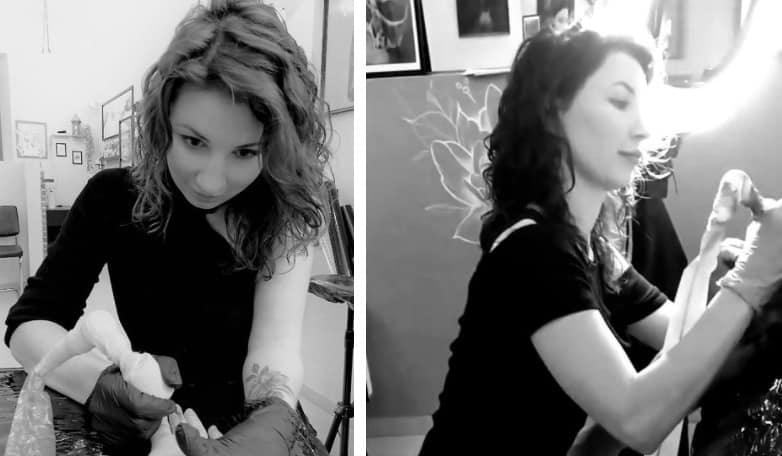
Thank you for reading my article, I hope that you have found it helpful. If you would have trouble finding ideas for your tattoo, wonder what is meaning of design that you have found or what to buy for aftercare, to make sure that your tattoo will be healing quickly and easily, here are some of my favorite products in one place, hope that this will also help.
Design and tattoo ideas
For some ideas you can have a look at those 3 books with hundreds of designs that I use with my clients, they are available on Amazon for Kindle or in classic, paper version (links below):
- Great Book of Tattoo Designs, Revised Edition: More than 500 Body Art Designs (Fox Chapel Publishing) Fantasy, Celtic, Floral, Wildlife, and Symbol Designs for the Skin by Lora Irish
- The Big Book of Small Tattoos – Vol.1: 400 small original tattoos for women and men by Roberto Gemori
- Tiny Tattoos: Over 1,000 Small Inspirational Artworks by Rebecca Vincent.
Tattoo meaning
If you would like to read more about the meaning of different tattoo styles and designs before you will decide what you would like to have, I can recommend a book that was really useful for me when I was starting my tattoo adventure – it’s “Conscious Ink: The Hidden Meaning of Tattoos” by Lisa Barretta (through the link you can find it on Amazon for around $10).
Tattoo aftercare
The skin at the tattoo site often dries out. To prevent it and speed up healing for my clients, I usually recommend one of those tattoo aftercare balms (you can find them on Amazon):

